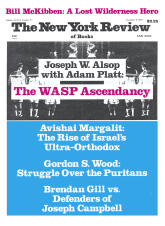In response to:
The Fall of a Great Museum from the April 27, 1989 issue
To the Editors:
In his article on the goings-on at the V & A [NYR, April 27], Sir John Pope-Hennessy had not space perhaps to dwell longer on the betrayal of trust vis-à-vis the curators. As something similar seems to be happening in this country, it is worth noting. A curator has chosen a low paying profession to give her or his efforts to developing or articulating a collection for the instruction and delight of us all. That same curator could well have chosen to become a dealer with much greater salary and independence of life.
Certainly they tend to become “barons” and protective of the objects. This has been interpreted as a sign of contempt for “the public.” It is curious to criticize someone who, for not much money, spends a lifetime cataloguing, preparing exhibitions, giving lectures, publishing. The curators’ aggravation is not directed towards the public, which, in general, is modest about its knowledge and wants to learn. It is the ignorant self-important who raise the ire: those who, if they don’t understand something, want to change the “something” rather than make the effort to understand. And, as is usual among the wilfully ignorant, claim that everyone else (“the public”) is like them. Any teacher can describe the phenomenon.
Curiously concomitant to this contempt for curators, is the low level of the appeal to the “fat-cats” for financial support. In an art “market” with thirty and forty and fifty million dollar pictures, the amount of money asked by museums for someone to become a “member of the supporting club” is in these terms, rather small. J.P. Morgan would have scoffed at it as small stuff. By “selling” themselves too cheaply, museum administrations devalue the importance of the collections, and concurrently, the cultural efforts of the curators of these collections. It is failure of nerve, and a needless one.
I remember starting as a librarian in the 1950s when there was a great struggle to include librarians (then earning $3500 a year) into the Social Security System. When asked how librarians would support themselves on retirement, Irving Olds, then chairman of the New York Public Library, replied: “On their savings.” There is a smell of the same attitude in the air.
When asked by students of the Institute of Fine Arts if I know of job openings, I can, in honesty, only strongly recommend that they go into the gallery—money-making—side. They will earn no respect otherwise.
The goings-on at the V & A sadly confirm this.
Gabriel Austin
Wittenborn Art Books, Inc.
New York City
This Issue
November 9, 1989



